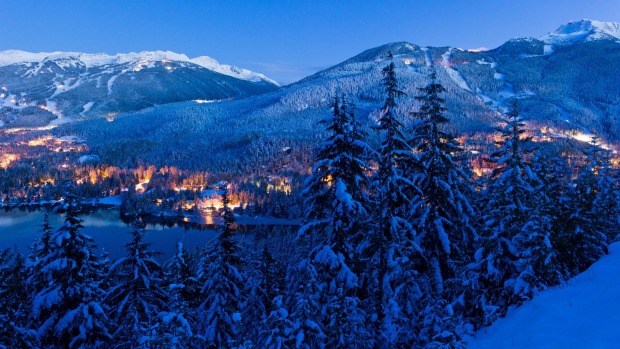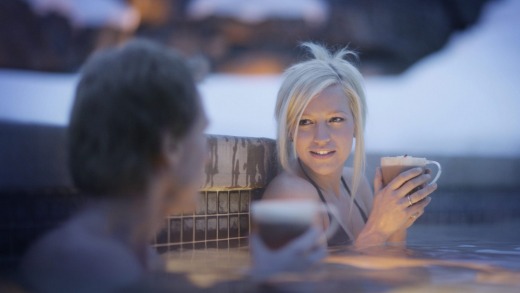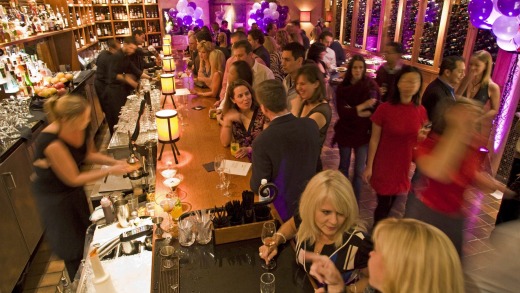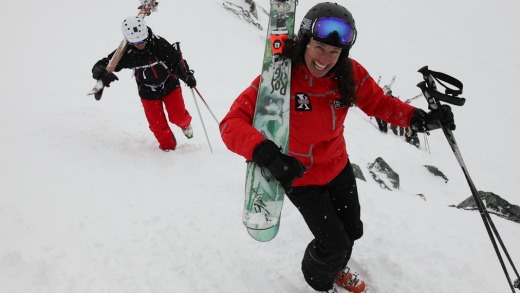
If you think of a ski resort as a pretty mountain village with snow-capped peaks soaring above, some glamorous people promenading the pathways and tanned sporty types hurtling down the slopes, then Whistler has all that.
But is has so much more; it has gone way beyond being a resort, it's a metropolis with mountains attached; a location with a lifestyle, and despite its size and popularity, there is still some heart and soul.
"Some people come here for a gap year," says one local on a ski-lift, "and they end up staying for a gap life." She's right, and they've given the place its character – total enthusiasm for outdoor pursuits and a total appreciation of the mountain environment and culture.

Summer here is almost as busy as winter, with mountain hikers and bikers exploring the terrain, people paddling on the rivers and lakes and some still skiing on the glaciers way up high.
The permanent population is 10,000, there are 30,000 visitor beds and on a big day – Vancouver is an easy drive away and Seattle not so far either – the Whistler area can be hosting 70,000 people.
Summer here is almost as busy as winter.
So the mountain can get crowded – there's enough room on the slopes, but the lift queues can be lengthy.

That makes it all the more appealing to take a ski or snowboard lesson, or a clinic, which comes with lift priority: you get to cut to the front of the queue.
We are to ski for a day with Extremely Canadian, a Whistler-born tuition and guiding service that shows skiers and boarders how to handle this vast area's steeper terrain.
Our coach Wendy Brookbank, from nearby Pemberton, spent time on the ski competition circuit, was in the world's first televised extreme skiing event (1991, Juneau, Alaska) and now applies her considerable skills as a skier and talents as a teacher to people who want to improve their angles.

There's a lot of skiing and just the right amount of theory passed on: "You can't cloud people's minds with too much detail, especially in challenging terrain where they might be more nervous," Wendy says.
We position ourselves for the drop at the top of Whistler Bowl; there's the lip of a cornice to deal with first and while it won't make the movies, there's still the risk of a tricky tumble into the terrain below. The bowl opens up nicely, but if you miss the entry from the cornice, you'll be sliding down that slope for an uncomfortable while before you pull yourself up.
That allows some time for thinking about all the things that could go wrong ... Wendy keeps it simple: "Keep a defensive hand below you, hold that downhill pole straight out from your body, that'll help your stance but will also be there if you need it.
"Keep your chin up and your eyes and head still, not moving, and pointing down the hill in the direction of the turn."
The snow is hard-packed and she points out that "it'll go ka-thunk, ka-thunk, ka-thunk". "Just absorb it," she says.
It does and we do – and after the tricky entrance, the turns on the steep terrain are a sweet return. Once you have your rhythm and confidence, it's like free-falling.
We cover a lot of ground. There are two huge mountains – Whistler and Blackcomb – both with glaciers at their higher reaches and long, entertaining runs moving down from the open slopes and into the forests.
It gives the mix of terrain North American resorts are so well known for – some steeps for the challenge, but plenty of the long, scenic cruising runs that most people prefer to ride.
To connect the two mountains, before it hosted the skiing events of the 2010 Vancouver Olympics, Whistler built the Peak to Peak gondola and for fans of the engineering brilliance of ski lifts, it takes some beating.
It travels 4.4 kilometres and at its longest stretch has a 3.03-kilometre span between towers. At its highest point it is 463 metres above the ground. Look away now if you get vertigo: it even has some cars with glass floors so you can get the full viewing experience.
We use it to cross from Whistler Mountain to Blackcomb then ride its lifts up to Blackcomb Glacier. There we climb up a ridge on a stretch called Spanky's Ladder to ski gems of bowls known as Diamond and Sapphire.
I peer over the edge, neck out like a stork to find the friendliest way in. "Hey there Hugo," says Wendy, as a tall, athletic skier climbs the last few steps to the lip, clicks into his skis and replies with a "how's it going Wendy", before leaping into Diamond Bowl and making it shine.
There goes Hugo Harrison. He is to big mountain skiing – judged descents on steep terrain with speed, style and creativity – what Roger Federer is to tennis.
They're the kind of people you keep bumping into around here, the Hugos and the Wendys – devoted skiers and snowboarders who either grew up on these slopes or arrived here along some fortuitous path and just never saw the reason to leave.
It's difficult to argue with their reasoning.
whistler.com
hellobc.com
canada.travel
Air Canada flies direct between Sydney and Vancouver year-round and Qantas has direct flights during the northern winter. Pacific Coach Lines runs an excellent shuttle between Vancouver Airport and Whistler (about 2½ hours) and it's a scenic drive with city, water and mountain views; see pacificcoach.com.
Vast choices in a village this size. Creekside is laid-back and a 10-minute taxi ride from Whistler's main village (party lovers might prefer the main village). Evolutions Apartment is handy to the lifts and a short walk to the Creekside Market for fresh food at reasonable prices; see lodging ovations.com.
Luggage restrictions on your flights might mean you're better off hiring skis or snowboard in Whistler; have it included with your lift ticket for some savings. Both can be bought online or packaged with accommodation and flights through a travel operator. Mogul Ski World, Skimax and Travelplan are among the more active in this market, see: mogulski.com.au; skimax.com.au; travelplan.com.au.
Third-generation Australian chef Nick Cassettari was lured to Whistler by the snowboarding and it's the resort's great gain. His food is creative, inspired and memorable: how about an entree of prawns, tuna, scallops, avocado and a pea mash, with toast cooked in prawn oil to scoop it up. See altabistro.com.
Fine dining in an opulent, clubby kind of room with whimsical cocktails, fresh seasonal food and excellent Canadian wines to match: seared Alaskan scallops with an Okanagan Chardonnay, for starters, as fine a pairing as skis and snow. If you loved the meal, you might want the book, chef James Walt's award-winning Araxi. See araxi.com.
Japanese food is such a staple in North American resorts, it can be as ho-hum as a hamburger. But Sachi Sushi does its namesake dish superbly, its spicy Agedashi tofu is outstanding and if you have the sashimi, you'll be having fish from not far away, such as albacore tuna or Canadian salmon. See sachisushi.com.
Every ski town needs a humming pub with a lively apres scene that doesn't really calm down until closing and Dusty's is the one here. At Creekside, the service is exceptionally friendly and the ribs generous and good, as is the chicken soup if you're looking for something more humble. See facebook.com/dustyswhistler
Most of the way up Whistler Mountain, Steeps is a full-service oasis in the hectic hub known as the Roundhouse Lodge. Its focus is fresh, seasonal food, much of it from British Columbia, including sensational salmon. The setting isn't bad either – at 1850 metres, lunch comes with some excellent mountain views. See whistlerblackcomb.com.